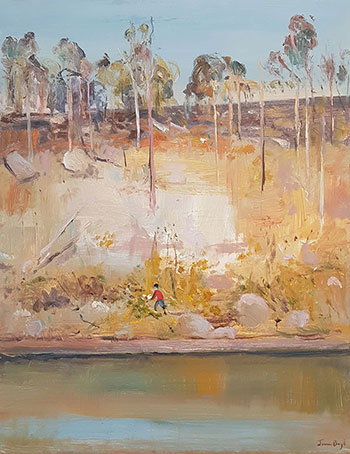
Jamie Boyd’s present works communicate a thoroughly immersive engagement with the landscape. Although now based in London, he regularly returns to the Shoalhaven River area in SE New South Wales. It was here that his father Arthur acquired the Riverdale and Bundanon properties in the 1970s. They were subsequently gifted to the Australian people for Artist Residencies and creative projects in 1993.
The exhibition’s title, Return to the River, alludes to Boyd’s visit last year to the riverbank below the famed Pulpit Rock rising from a bend in the Shoalhaven just across from the Bundanon Trust land. He tells of the locale’s inspiration for him; “The topography resonates because it is uncomplicated and there is little evidence of human presence – just rocks, water, trees and sky… but all in a wonderfully proportioned scale, as if made for painting.”
Bearing the same title as the exhibition, the Return to the River work has an arid quality in its pale, earthy-hued rock strewn escarpment and stick-like trees devoid of verdant foliage. Vibrant blue stretches across the picture plane in the overhead, cloudless sky. The same colour is repeated in the foreground river flow. Interrupted only by the scattering of ill-defined trees, the composition’s horizontality promotes a sense of pervasive stillness.
Other smaller works on copper panels evince a similar quietude. The occasional river craft is always a rowboat so as not to disturb the tranquil ambience. Tiny figures on the shores signify the ‘diminutiveness’ of mankind in comparison to the majesty of the untamed natural world.
The Riverbank Reflection canvas has an entirely more robust aesthetic in its overt expressionistic application of tempera medium and high-pitched, incongruous colours. Boyd discloses that this work references an oil sketch he’d made some years ago on the Shoalhaven River. Most surprisingly, this painting was actually created en plein air in an Italian olive grove! He relates that the experience and process was such that he was very tempted to render the piece utterly abstract. Preferring painterly sketches and drawings made in situ, along with abundant memories, Boyd rarely uses photographs as reference material.
Not merely landscape depictions, Boyd’s paintings encourage the viewer to discern what exists beyond the manifest – to be receptive to Nature’s aesthetic bounty and encounter one’s own presence within that timeless realm.
JACQUELINE HOUGHTON
Receive e-mail updates on our exhibitions, events and more
Subscribe Now